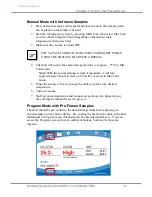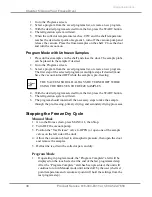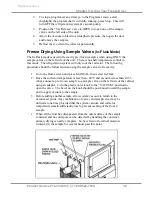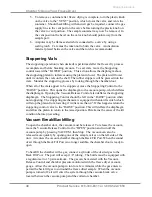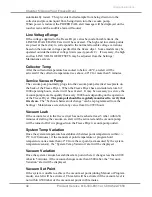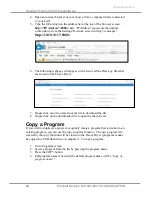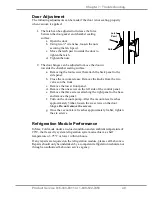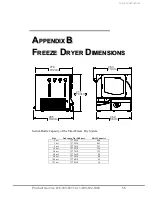
Chapter 7: Troubleshooting
Product Service 816-333-8811 or 1-800-522-7658
51
8.
Connect the unit to the proper power source. Activate the pump from the
display screen (Home screen) by selecting MANUAL, entering 24°C (in
Shelf Temp Set Point entry field), and pressing Start. This will start the
heat transfer fluid pump and also the refrigeration system. The fluid
system will circulate with the fluid going through the add-on tubing,
purging itself of air. Add fluid when needed to keep fluid in the reservoir.
After the fluid stream is established, tilt the entire freeze dry system up
and down. Observe the fluid stream and repeat the tilt procedure if it is
not free of bubbles. Fill reservoir to level indicated by the label.
9.
Turn the pump and refrigeration system OFF by pressing MANUAL, then
Stop. Disconnect power cord from supply outlet.
10.
Close “up-seat” fluid circulation valve (turn valve stem completely
counter-clockwise, closing the fluid/tubing by-pass).
11.
Remove the tubing. Replace the caps on the valve and replace insulation
and covers. Replace the cap on the tank.
12.
Replace insulation and seal air tight. Replace rear cover.
Heat Transfer Fluid Precautions
The fluid’s name and manufacturer are:
Name: Lexol 542
Manufacturer: Santa Barbara Chemical Co.
927 Indio Muerto
Santa Barbara, CA 93140
805-963-7793
The fluid used for heat transfer in this system is combustible
and hazardous. Leaks and spills should be attended to
immediately or serious injury could occur.
Handling and Storage Precautions – Dirty Solvent:
Store in
accordance with all applicable regulations. Tighten caps and store in
a cool area.
Precautions if Material is Released or Spilled:
Spills should be
contained immediately. Spills may be soaked up with absorbent
materials, placed in closed containers, labeled, stored and disposed of
properly. Persons performing this work should wear adequate
personal protective equipment and clothing.
Disposal of Non-Recyclable Solvents:
Dispose of in accordance
with all federal, state, and local health and pollution regulations.
Follow same guidelines as when disposing kerosene.
!

